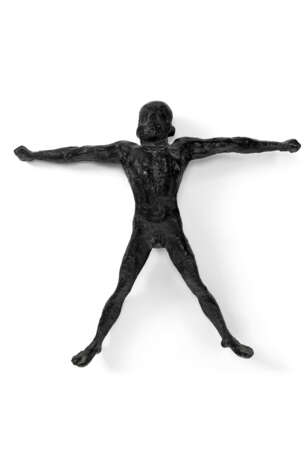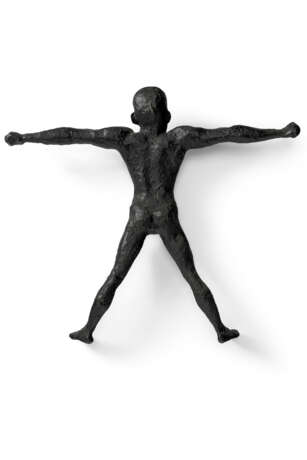ID 1031658
Lot 219 | ISAMU NOGUCHI (1904-1988)
Valeur estimée
$ 50 000 – 70 000
Glad Day
bronze
18 ½ x 21 x 4 1/8 in. (47 x 53.3 x 10.5 cm.)
Executed in 1930. This work is one of three from an unnumbered edition.
Provenance
Miriam Hopkins, New York, acquired directly from the artist, circa 1934
Private collection, by descent from the above, 1972
Private collection, by descent from the above, 2010
By descent from the above to the present owner, 2016
Literature
"Isamu Noguchi," New York Herald Tribune, February 1932.
I. Noguchi, "Shelters of the Orient," Shelter 2, vol. 2, no. 5, November 1932, p. 96 (another example illustrated on the covers).
"Isamu Noguchi," Town & Country, 1932 (another example illustrated).
I. Noguchi, Isamu Noguchi: A Sculptor's World, New York and Evanston, 1968, pp. 19 and 241, no. 14 (another example illustrated).
S. Hunter, Isamu Noguchi, New York, 1978, n.p., no. 204 (another example illustrated).
D. Botnick and N. Grove, The Sculpture of Isamu Noguchi, 1924-1979: A Catalogue, New York and London, 1980, pp. 70 and 207, no. 77 (another example illustrated).
B. Altshuler, Isamu Noguchi (Modern Masters Series), New York, 1995, pp. 20 and 126.
Isamu Noguchi Foundation and Garden Museum, The Isamu Noguchi Catalogue Raisonné, digital, ongoing, no. 77-3/3 (illustrated).
Exhibited
Cambridge, Harvard Society for Contemporary Art, Watercolors by a Group of Five and Bronzes by Isamu Noguchi, February-March 1930 (an example exhibited).
The Arts Club of Chicago, Sculpture by Isamu Noguchi, March-April 1930 (an example illustrated on the exhibition pamphlet).
New York, John Becker Gallery, Sculpture by Isamu Noguchi, February-March 1932 (an example illustrated on the exhibition pamphlet).
Philadelphia, Mellon Galleries, Sculpture and Drawings by Isamu Noguchi, February-March 1933 (an example illustrated on the exhibition pamphlet).
New York, Whitney Museum of American Art, Exhibition of the Work of the Artist Fellows of the John Simon Guggenheim Memorial Foundation, April 1933 (an example exhibited).
The Arts Club of Chicago, Exhibition of Modern Sculpture and Drawings by Sculptors, June 1933 (an example exhibited).
Honolulu Museum of Art, Isamu Noguchi, May-June 1940 (another example exhibited).
Tokyo, National Museum of Modern Art, Isamu Noguchi Retrospective 1992 Japan, March-May 1992 (another example exhibited).
New York, The Isamu Noguchi Foundation and Garden Museum, Best of Friends: Buckminster Fuller and Isamu Noguchi, May-October 2006 (another example exhibited).
New York, The Isamu Noguchi Foundation and Garden Museum, On Becoming An Artist: Isamu Noguchi and His Contemporaries: 1923 – 1960, November 2010-April 2011, p. 57 (another example illustrated).
Ann Arbor, University of Michigan Museum of Art, Isamu Noguchi and Qi Baishi: Beijing 1930, September 2013-January 2014, pp. 22, 26, 83 and 91, fig. 16 (another example illustrated).
Further details
Crafted in 1930, Isamu Noguchi’s Glad Day embodies a vibrant celebration of the boundless potential of humanity and the unrestricted realm of creative expression. Here, the figure is depicted as fully outstretched, with joints unbent and extended to the maximum of the human form. This imagery may relate to Michelangelo’s Vitruvian Man but most certainly draws inspiration from the universal theories of Buckminster Fuller, who owned another cast of this work. Fuller spoke of the interconnectedness of nature and the entire universe, epitomized by the figure’s outstretched limbs which suggest expansiveness, and the role of humans within it.
Born in the United States, Noguchi spent his early years in Japan, where the tapestry of Japanese art and culture profoundly shaped him. His subsequent visit to Japan led him to explore its sculptural traditions and ceramics. This influence is present in Glad Day through the synthesis of new materials and the abstracted melding of both nature and science. With these new innovations, Glad Day represents an important, emergent moment in the artist’s career.
Upon his return to the United States in 1932, he sculpted Miss Expanding Universe, a work that shares thematic and compositional elements with Glad Day, as Noguchi seamlessly merged the sleek lines of the machine age with the intrinsic features of ancient Japanese funerary sculptures, known as haniwa. Noguchi’s polished nickel-bronze sculpture Death, executed in 1934, also bears similarity to Glad Day in its form, drawing parallels with its artistic representation. Inspired by the 1930 lynching of George Hughes in Texas, Death portrays a nearly life size representation of a lynched man, suspended by a rope from a metal mount. While in Death, the figure’s body pained and contorted, Glad Day depicts a figure with limbs outstretched, as if it is breaking free or in defiance. The sculpture is a testament to Noguchi’s early exploration of the human form in its many dynamic states of being.
The present edition of Glad Day found its home with Miriam Hopkins, a notable figure within the New York Avant Garde circle, who acquired it directly from the artist circa 1934. Ellen Miriam Hopkins (1902-1972) was a versatile and renowned American actress particularly active in the 1930s. Debuting in “Fast and Loose,” she soared in films like “The Smiling Lieutenant” and “Design for Living,” establishing herself as a cinematic icon. With diverse roles, an Oscar nod for “Becky Sharp,” and collaborations with Joel McCrea, she left a lasting mark. While she is primarily remembered for her acting career, Hopkins was an important patron of the arts. Her involvement in the arts date back to her early years as a struggling actress in New York. Hopkins posed for artist Harry Stoner and soon became his favored muse. Additionally, she served as a model for artists John Carroll and her close friend Jean Negulesco. When Hopkins crossed paths with Isamu Noguchi, she acquired a selection of his works and also commissioned a gold-played bronze sculpture of herself. Later encouraged by Hopkins, Noguchi travelled to Hollywood to create artworks of her circle of friends.
| Artiste: | Isamu Noguchi (1904 - 1988) |
|---|
| Artiste: | Isamu Noguchi (1904 - 1988) |
|---|
| Adresse de l'enchère |
CHRISTIE'S 20 Rockefeller Plaza 10020 New York Etats-Unis | ||||||||||||||
|---|---|---|---|---|---|---|---|---|---|---|---|---|---|---|---|
| Aperçu |
| ||||||||||||||
| Téléphone | +1 212 636 2000 | ||||||||||||||
| Fax | +1 212 636 4930 | ||||||||||||||
| Conditions d'utilisation | Conditions d'utilisation | ||||||||||||||
| transport |
Service postal Service de messagerie ramassage par vous-même | ||||||||||||||
| Modes de paiement |
Virement bancaire | ||||||||||||||
| Heures d'ouverture | Heures d'ouverture
|












